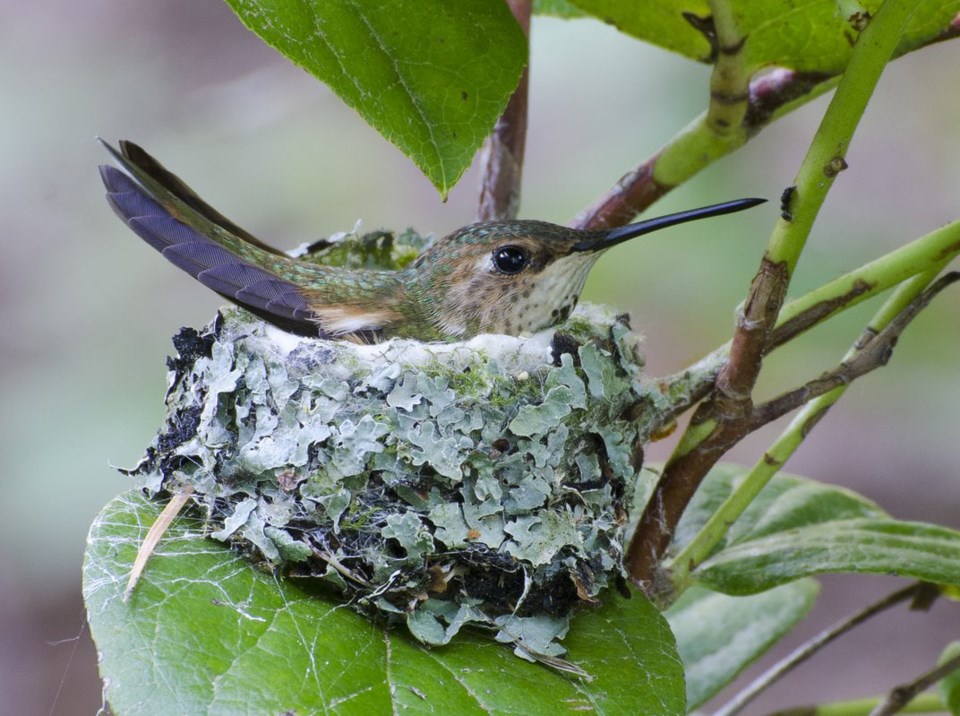About 100 metres down the road a monster mansion is under construction. For weeks heavy machinery and trucks have been roaring and rumbling through the neighbourhood. They’ve disgorged lumber and other supplies, sourced from goodness knows how far away. The whining and banging noises rattle our already frayed nerves.
At this time of the year, another kind of construction is in progress. The noise level is almost nonexistent. In fact, any sounds associated with the work are sweet – more like music than din and racket. Every day for a few weeks now I’ve been listening to the birds, trilling, warbling, singing joyfully and purposefully as they flutter in and out of the trees. It’s mating season – which means nest building.
We’re home to a variety of birds, who construct a variety of nests in a variety of locations. They don’t use grinding or polluting machinery. They don’t destroy anything in the course of work. They get their materials locally.
They find their supply of twigs, leaves, grasses, moss, lichen, feathers, and soft, downy materials in trees, fields, gardens, yards. If you’ve let nature have the upper hand in your yard over the winter, the birds will find a lot of what they need. Dandelions are a godsend since they bloom early. Once it’s pollinated by an insect, the dandelion produces seeds, which push through the florets and develop fluffy white filaments, used especially by hummingbirds for nest construction (some birds also eat the seeds during nesting season). Dry grasses are good construction material as well. I’m plagued by quack grass but restrain myself from pulling all of it out while nests are being built.
Where do birds locate their nests? Chickadees choose natural cavities in dead or rotting trees (they love birches) or cavities abandoned by woodpeckers. The nesting sites of house finches include cavities, old nests of other species, as well as ones newly constructed by them in trees. Juncos often build their nests on the ground, against tree trunks or in tall vegetation, which is why we need to be careful where and how we trim our yards and fields. The junco’s nest, like that of most other song birds in our area, has an open cup shape, woven of grasses and plant fibres and lined with softer materials. Also the song sparrow tends to nest quite low, sometimes on the ground and sometimes in shrubs or low trees. The nest is constructed with grasses, leaves, weeds, and bark strips. For the interior, softer vegetation and animal hair is used.
Hummingbird nests often sit on the forks of branches in sheltered bushes or shrubs. Made of soft plant fibres held together by strands of spiderwebs, these tiny nests are stretchy, able to expand to hold the nestlings until they fledge, usually after 3-4 weeks. Because the nests are so small and well camouflaged, they’re difficult to see and often succumb to the tools of the arborist – a reason to discourage (or even outlaw) bush and tree trimming during the nesting season.
One of the greatest joys has to be the discovery of a bird’s nest in your yard – a sign that you have been deemed a trustworthy human, surely an enormous honour today, when humans are wreaking so much damage, destroying habitats, arrogantly assuming they are the masters of all.
Sabine Eiche is a local writer and art historian with a PhD from Princeton University. She is passionately involved in preserving the environment and protecting nature. Her columns deal with a broad range of topics and often include the history (etymology) of words in order to shed extra light on the subject.



